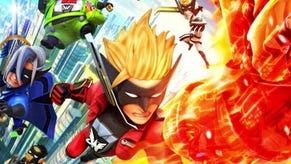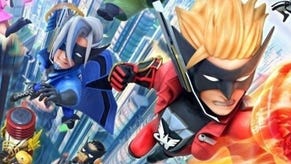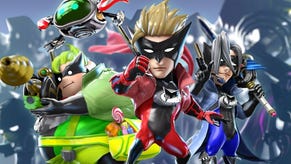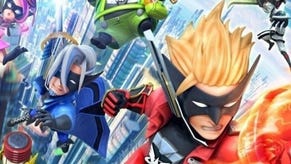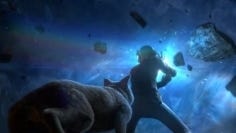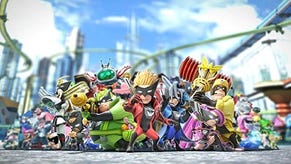The Wonderful 101 Remastered review - a curious gem made that bit more palatable
Anarchy reigns.
I've always loved the fact that Platinum Games' wildest effort was saved for one of the wildest consoles in recent years - even if it did mean it got lost in the wilderness a little. If you were in on the Wii U cult, though, The Wonderful 101 was one of the real prizes; a scattershot take on action games from the man who helped birth the genre, it was a colourful grab-bag that was at once maddening and magical, throwing together tokosatsu-inspired superheroes with a thrillingly off-kilter combat system.
It was something of an acquired taste, though the remaster that sees The Wonderful 101 arrive on Switch, PC and PlayStation 4 does make an effort to appeal to a broader range of palates. They're slight, welcome tweaks - some smart work has been done to bridge the divide between the Wii U's two screen setup, you'll be getting better performance on PC even if the Switch version isn't quite the measure of the original, while elsewhere there's a bit more guidance early on how to get the most out of your moveset plus a few handy tools available from the off to flatten the learning curve - though don't go in expecting a substantial makeover. What you're getting instead is something that makes it that little bit easier to appreciate what makes The Wonderful 101 shine.
And what is that exactly? For me it's the chance to see Hideki Kamiya at his most unhinged, throwing in everything from a life obsessed with video games and Japanese popular culture. It's where hundreds of masked superheroes clash noisily against alien invaders and each other across tiltshift metropolises in a game that's maximalist from its core outwards. Why just control the one superhero when you can have an entire mob at your fingertips? It sounds like chaos, and in practice it very much is.
Filter through the noise - and it takes a while to do so - and for all that chaos you'll find plenty that's familiar. In the design of the heroes who you meet along the way to recruit into your team you'll see shades of Viewtiful Joe, in the combat there's more than a dash of Bayonetta while in the sketching you perform to draw weapons there's something of Okami's brush mechanic. It's a lot, in other words, and it doesn't always come together in perfect harmony.
Primarily, though, this is cast in the mold of action games like Devil May Cry or Bayonetta - even if it does often spill over the sides with its unchecked energy - where you're learning attack patterns of enemy types, studying their weaknesses and slowly understanding what the best tool is for any given encounter. The mob around you effectively acts as a cushion for the sole hero leading the charge, and they can be shaped via your Wonder-Liner into a growing number of weapons - Guns! Whips! Swords! Claws! - through the power of Unite Morph.
And that's where things get stranger still. Essentially these are just different weapons, but the act of selecting them is done by drawing a line either on the screen if you're playing undocked on Switch or by moving the right stick. It's a mechanic that made sense on the Wii U, built as that was around the second screen, but even then it was imperfect - Kamiya himself prefers the right stick method, and it's the one I personally swear by even when playing undocked on Switch. Even then, though, it's an often imprecise tool that can have you fumbling around, especially once you've unlocked later weapons that require more intricate illustrations than a simple line or circle.
Thus a scrappier game becomes scrappier still, something exacerbated by Kamiya's love of set-pieces and throwaway mechanics that make fleeting appearances - there's the infamous Punch-Out section, some racing sections and no shortage of shooter-inspired scenarios. It's heady stuff that just gets headier and headier until, when you're nearing the finish line of a campaign that's that little bit longer than your standard Platinum game, you wonder whether your head is in danger of exploding.
It's no surprise so many bounced off The Wonderful 101 first time around, and there's a good chance they'll do so again with this remaster, though I've relished the chance to play through it all once more. This is the antithesis of something like Devil May Cry 5, an action game with an eminently readable brand of combat as opposed to the scrawl that's on offer here, but in its own way it works just as well - as long as you don't try to make too much sense of it.
Platinum Games has made a handful of masterpieces in its short tenure - most recently last year's Astral Chain, a sterling reminder of what makes this studio special - and while the remaster makes me love The Wonderful 101 that little bit more I'm not entirely convinced it's up there with the very best. It's too anarchic, too messy and too unreadable in its combat, as well as too erratic in its execution. But then it's that anarchy that's key to The Wonderful 101's charm, and that runs through so much of the work of Hideki Kamiya. The Wonderful 101 is Platinum at its most imperfect, but I don't necessarily mean that as a slight. There's a real thrill to be found in all that chaos.





